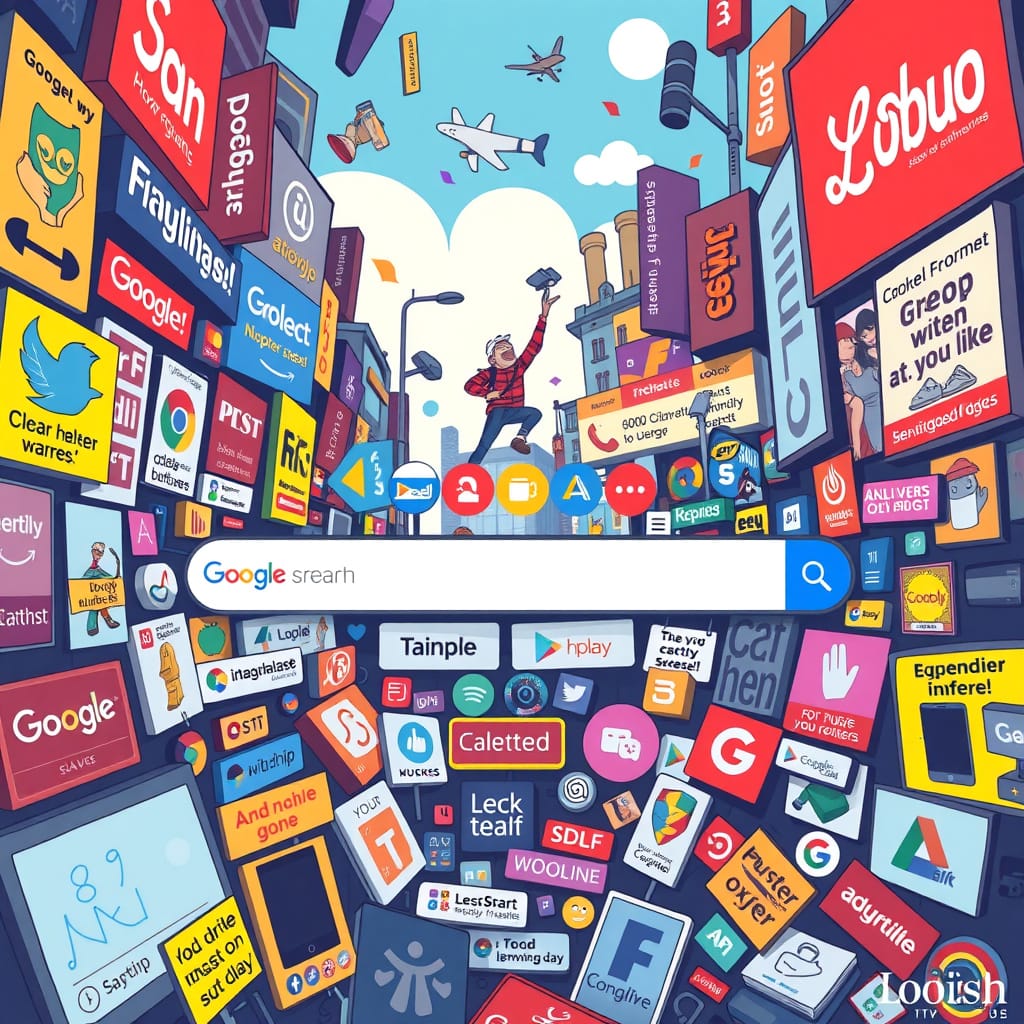In what company executives are calling “the natural evolution of the search experience,” Google has unveiled its long-rumored Premium Search subscription service, promising users the revolutionary opportunity to occasionally glimpse actual websites amid a sea of targeted advertising. For just $9.99 per month – approximately the cost of three clicks on a “best mattress” Google Ad-subscribers will gain access to a search engine that vaguely resembles the one you used for free back in 2010, which on the internet seems like centuries ago!
The announcement comes as the search giant faces increasing scrutiny over its search result quality, with recent studies showing that only 36% of Google searches now lead users to the open web, while the remainder trap users in Google’s own ecosystem of products, services, and increasingly desperate attempts to monetize your curiosity about whether cats can eat broccoli and enjoy it.
The Premium Search Experience: Like Regular Search But With 17% More Internet
According to the lavish press release issued from Google’s Mountain View headquarters – a document containing precisely 42 instances of the phrase “enhancing user experience” and zero mentions of “revenue extraction” – Premium Search will offer subscribers an array of features previously thought extinct, such as “organic results above-the-fold” and “the ability to find information without first scrolling past seventeen nearly identical products you have no intention of purchasing ever.”
“We’ve heard from our users that they enjoy the thrill of potentially discovering relevant information after engaging with several pages of carefully curated shopping opportunities,” explained Dr. Veronica Matthews, Google’s newly appointed Chief Revenue Persistence Officer. “With Premium Search, we’re streamlining that experience by occasionally showing you what you actually searched for without requiring an archaeology degree.”
Internal documents reportedly reveal that Premium Search will reduce the current standard of 85% ad coverage to a more modest 65%, allowing users to experience what company insiders are calling “nostalgic glimpses of the information superhighway” between promotional content.
The Science of Search Degradation: A Journey of Discovery
The development of Premium Search reportedly began after Google analysts made a startling discovery: reducing search quality had virtually no impact on the company’s market dominance or revenue generation. Despite user complaints about result relevance and ad saturation, Google’s search engine market share remained stubbornly fixed at approximately 90% throughout 2024.
“It was an absolute eureka moment,” said Thomas Rutherford, Google’s SVP of User Tolerance Assessment. “We realized we could gradually decrease the quality-to-advertising ratio by approximately 3.7% per quarter without triggering mass user exodus. The question quickly became not ‘how do we maintain search quality?’ but rather ‘how far can we push this before people notice enough to actually change their search behavior?'”
The answer, it seems, was much further than anyone anticipated. Recent behavioral studies reveal that most Google users now spend 14.6 seconds on average before clicking a result, with 50% clicking within 9 seconds – barely enough time to distinguish between an actual result and a cleverly disguised advertisement.
Even more tellingly, only 9% of users ever make it to the bottom of the first page of results, suggesting that most have either found what they’re looking for or, more likely, have accepted defeat and settled for whatever Google has placed in their path.
The Tiered Subscription Model: Choose Your Own Financial Adventure
Premium Search will launch with three distinct subscription tiers, each offering progressively more access to what was once simply called “search results”:
The “Basic Explorer” tier ($9.99/month) eliminates shopping ads for non-commercial searches and guarantees that at least two organic results will appear above-the-fold – a 200% increase from the current standard.
The “Digital Archaeologist” tier ($19.99/month) reduces total ad load by 40% and introduces the groundbreaking “Result Relevance Guarantee,” which ensures that at least 50% of first-page results will have some tangential relationship to your actual search query.
The flagship “Internet Rememberer” package ($49.99/month) offers the premium experience of “2010 Mode,” recreating the quaint historical period when Google primarily functioned as a tool for finding information rather than a sophisticated shopping mall with occasional factual content.
“We’re particularly excited about the Internet Rememberer tier,” explained Jennifer Blackwood, Google’s Director of Nostalgia Monetization. “Our research shows that users over 30 have powerful emotional connections to the concept of ‘finding things on the internet,’ and we’ve developed a way to leverage that nostalgia into an optimized revenue stream.”
The AI Justification: Computing Power Doesn’t Grow on Trees (Except in Our Carbon Offset Programs)
Google executives have justified the subscription model by pointing to the computational costs of their advanced AI systems, particularly the Search Generative Experience (SGE) and the recently launched AI Mode.
“Generating AI responses requires significant computational resources,” explained Dr. Harold Fitzwilliam, Google’s Director of Financial Explanation Creation. “For example, when you ask a complex query like ‘What’s the difference between sleep tracking on smart rings versus smartwatches?’ our systems must analyze billions of data points, consult multiple sources, and craft a comprehensive response that saves you the trouble of visiting any of the websites that actually created that information.”
What Dr. Fitzwilliam failed to mention was that Google generated $175 billion in search-related ad revenue last year alone, a sum that could theoretically power the entire computational needs of SGE while leaving enough surplus to end world hunger, solve climate change, and still fund a modest space program.
When pressed on this point at the announcement event, Google CEO Sundar Pichai reportedly stared blankly for 9.3 seconds before responding, “The future of search is a journey we’re taking together with our users and advertisers,” a statement that received thunderous applause despite containing no actual information.
The True Cost of Free: Your Data, Your Soul, and Now Your Credit Card
Perhaps the most remarkable aspect of Premium Search is its adherence to Google’s core business model: even paying subscribers will still see ads. The $9.99 monthly fee merely reduces their volume and adjusts their prominence, creating what one anonymous Google engineer described as “the illusion of escape from our advertising ecosystem.”
“It’s really quite brilliant,” explained digital economist Dr. Victoria Chang. “Google has created a problem – the oversaturation of search results with ads – and is now charging users to partially solve that same problem. It’s like charging people to use slightly less uncomfortable airplane seats after systematically making all airplane seats uncomfortable.”
This strategy aligns perfectly with internal research showing that humans will pay substantial sums to temporarily alleviate artificially created discomfort. The same research indicated that 73% of users who complained about Google’s ad-heavy results would still prefer paying Google to fix the problem rather than switching to an alternative search engine.
“Our user surveys show a fascinating psychological phenomenon,” noted Dr. Marcus Wellington, Google’s Chief Behavioral Economist. “Even when presented with free alternatives, users express a preference for paying to continue using the degraded service they’ve grown accustomed to. We call this the ‘Stockholm Search Syndrome.'”
The Curious Case of the Search Engine That Stopped Searching
The most overlooked aspect of Premium Search may be what it reveals about Google’s long-term strategy. By charging for a slightly less advertising-dominated experience, Google effectively acknowledges what critics have long suspected: the company’s primary purpose is no longer organizing the world’s information but rather monetizing access to it.
This represents the culmination of a gradual transformation that began years ago. What started as a simple, elegant tool for navigating the internet has evolved into an elaborate system for guiding users toward commercial transactions while extracting maximum value from their attention.
“The search engine’s purpose was originally to help you find things on the internet,” explained digital historian Eleanor Abernathy. “But somewhere along the way, that purpose shifted. Now its primary function is to help ads find you, with actual information discovery as a secondary or even tertiary concern.”
This shift is reflected in the user experience. Today, a typical Google search presents users with a complex obstacle course of Ai answers, ads, shopping results, featured snippets, and various SERP features before they can reach an actual website. Premium Search doesn’t eliminate this obstacle course – it merely removes a few of the more obvious hurdles.
The Future of Premium Search: Your Grandchildren Will Never Believe Search Was Once Free
Industry analysts predict that Premium Search represents just the first step in a broader strategy to monetize previously free aspects of Google’s services. Internal documents allegedly outline plans for additional premium tiers, including:
“Premium Gmail” ($7.99/month): Reduces the number of sponsored emails and guarantees delivery of important messages to your actual inbox rather than promotions or spam.
“Premium Maps” ($6.99/month): Shows routes that aren’t deliberately designed to pass sponsored businesses.
“Premium Android” ($14.99/month): Disables features that were intentionally designed to be confusing or frustrating unless you pay to fix them.
The most ambitious plan, however, appears to be “Premium Internet” ($99.99/month), which would theoretically allow users to experience the internet as it existed before it was optimized for engagement metrics and advertising revenue.
When asked about these rumored services, a Google spokesperson replied, “While we can’t comment on future products, we’re always exploring ways to enhance the user experience through innovative monetization strategies that create value for our advertising partners while maintaining the illusion of user agency.”
The Search Resistance: A Small But Growing Movement
Not everyone is embracing Google’s new premium model. A small but growing segment of users has begun migrating to alternative AI search platforms like Perplexity, which saw a 47% increase in traffic following Google’s announcement.
“I finally reached my breaking point when I searched for ‘symptoms of appendicitis’ and had to scroll past four ads for appendix-shaped throw pillows before I could find medical information,” explained former Google user Sam Mitchell. “By that point, my appendix had actually ruptured, which I suppose is the ultimate bounce-back to the search results page.”
Meanwhile, digital rights advocate Jennifer Patel has organized what she calls the “Search Liberation Front,” a movement dedicated to helping users break their Google dependency. “We run support groups where people learn to perform basic tasks like finding a recipe without first being shown 17 different Air Fryers they could purchase,” she explained. “The withdrawal symptoms can be severe – one man experienced panic attacks when he realized DuckDuckGo doesn’t know his location within three feet at all times.”
Whether these resistance efforts will impact Google’s dominant market position remains to be seen. As one analyst noted, “Google has achieved what economists once thought impossible: they’ve made their service progressively worse while simultaneously increasing both user numbers and revenue. It’s like a restaurant making their food gradually more expensive and less tasty, yet somehow attracting more customers who are willing to pay extra for slightly less terrible meals.”
Have you already received your Premium Search invitation, or are you still stuck with the peasant version where you have to scroll past seventeen shopping ads before you can learn if that rash is serious? Will you be shelling out $9.99 a month to slightly reduce the commercial content in your search results, or have you already joined the search engine resistance? Share your search horror stories or premium experiences in the comments below!
Support TechOnion
If you enjoyed this article and want to support independent tech journalism that doesn't literally charge you to read fewer ads, consider donating to TechOnion. For just $8.99/month (that's $1 less than Google Premium Search!), you can fund our ongoing investigation into whether the internet is actually still there beneath all the advertisements. Your contribution helps ensure we can continue to peel back the layers of tech absurdity without first showing you fourteen different types of vegetable peelers you might want to purchase. Remember: in a world where even Google is charging you to see slightly fewer ads, TechOnion remains committed to showing you exactly zero shopping recommendations for products tangentially related to onions.






GIPHY App Key not set. Please check settings
2 Comments